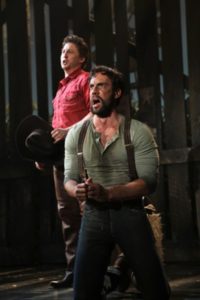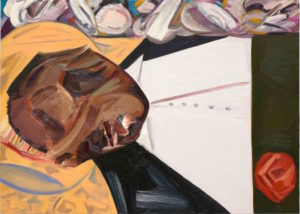 “This world is but canvas to our imaginations.”
“This world is but canvas to our imaginations.”
Henry David Thoreau, A Week on the Concord and Merrimack Rivers
Terry Teachout on the arts in New York City
 Mrs. T and I usually spend a couple of weeks each summer seeing shows in New England and Canada for The Wall Street Journal. That’s what we’re doing now. On Saturday we drove north from Connecticut to Maine, where we stayed at a seaside hotel, saw a revival of Ragtime that I liked enormously, bought underwear at an outlet mall, and ate lobster three nights in a row. Actually, it was Mrs. T who ate most of the lobster. Born and raised in Connecticut, she has an insatiable appetite for the stuff, and no sooner did the waitress at Lobster Cove bring us our evening meal on Saturday than she tore into it like a serial killer who’d just been sprung from solitary. Me, I stuck to shrimp and the odd lobster roll—I can’t see the point of spending so much time and energy prying dinner out of the red-hot shell of a freshly expired crustacean—but I live to please Mrs. T, so we always make a point of hitting the pounds and shacks when we’re in Maine.
Mrs. T and I usually spend a couple of weeks each summer seeing shows in New England and Canada for The Wall Street Journal. That’s what we’re doing now. On Saturday we drove north from Connecticut to Maine, where we stayed at a seaside hotel, saw a revival of Ragtime that I liked enormously, bought underwear at an outlet mall, and ate lobster three nights in a row. Actually, it was Mrs. T who ate most of the lobster. Born and raised in Connecticut, she has an insatiable appetite for the stuff, and no sooner did the waitress at Lobster Cove bring us our evening meal on Saturday than she tore into it like a serial killer who’d just been sprung from solitary. Me, I stuck to shrimp and the odd lobster roll—I can’t see the point of spending so much time and energy prying dinner out of the red-hot shell of a freshly expired crustacean—but I live to please Mrs. T, so we always make a point of hitting the pounds and shacks when we’re in Maine.
 On Tuesday we checked out of Cliff House and drove to Portland, where we spent a happy hour looking at Hans Hofmann: Works on Paper, a small but exceedingly choice exhibition on view at the Portland Museum of Art until September 3. Hofmann is one of our favorite painters—we actually own one of his rare prints—and we’ve both been longing to see this show, which traveled to Portland from the Museum of Contemporary Art in Jacksonville, Florida, ever since it was announced. (I would have liked to see the John Marin exhibition at the Ogunquit Museum of American Art, too, but I didn’t hear about it until after we’d left town.) I’ll be writing about the Hofmann show in detail later on, so suffice it for now to say that Karen Wilkin, the curator, has done an exemplary job of conveying the vibrant essence of Hofmann’s style within the narrow compass of a one-gallery show devoted solely to his works on paper.
On Tuesday we checked out of Cliff House and drove to Portland, where we spent a happy hour looking at Hans Hofmann: Works on Paper, a small but exceedingly choice exhibition on view at the Portland Museum of Art until September 3. Hofmann is one of our favorite painters—we actually own one of his rare prints—and we’ve both been longing to see this show, which traveled to Portland from the Museum of Contemporary Art in Jacksonville, Florida, ever since it was announced. (I would have liked to see the John Marin exhibition at the Ogunquit Museum of American Art, too, but I didn’t hear about it until after we’d left town.) I’ll be writing about the Hofmann show in detail later on, so suffice it for now to say that Karen Wilkin, the curator, has done an exemplary job of conveying the vibrant essence of Hofmann’s style within the narrow compass of a one-gallery show devoted solely to his works on paper.
From Portland we headed for Utica, New York, a city devoid of any claim to fame, though it used to be so crime-ridden that it came to be known as “the city that God forgot.” We didn’t stop there to see shows—if there’s any professional theater in Utica, I’m not aware of it—but merely to spend the night, several years’ experience having taught me that five hours of driving is all I care to do in one day. The local cuisine, it seems, is Italian, which was fine with me—I’d eaten more than enough seafood by then—so we went to an Italian steakhouse across the parking lot from the Holiday Inn Express, a family-friendly place whose female staff wears black fedoras, whose sound system plays the Complete Works of Dean Martin on an endless loop, and whose food, somewhat to my surprise, was much better than edible.
 We paused in Buffalo on Wednesday to lunch on beef on weck, a regional specialty, at Charlie the Butcher, a wonderful sandwich shop about which I learned from Roadfood. Then we crossed the border and made our way to Niagara-on-the-Lake, the smallish Ontario town that is home to the Shaw Festival, dining on jambalaya and split-pea soup that we’d picked up at Charlie the Butcher, after which we spent the rest of the evening reading in bed.
We paused in Buffalo on Wednesday to lunch on beef on weck, a regional specialty, at Charlie the Butcher, a wonderful sandwich shop about which I learned from Roadfood. Then we crossed the border and made our way to Niagara-on-the-Lake, the smallish Ontario town that is home to the Shaw Festival, dining on jambalaya and split-pea soup that we’d picked up at Charlie the Butcher, after which we spent the rest of the evening reading in bed.
My middle-aged love affair with Canada doesn’t seem to have abated in the slightest. No sooner did we cross the border than I felt completely at home, just as I always feel at ease in the company of my Canadian friends. The vast expanses of pancake-flat farmland and huge blue bowl of sky that surround Niagara-on-the-Lake remind me of southeast Missouri, the place where I grew up, with the slight, almost imperceptible accent and unselfconscious niceness of the locals lending a sweet touch of strangeness to the prevailing sense of familarity. I could imagine living in a town like this.
Save for meeting an old friend for dinner, we spent our first full day in town doing nothing, which suited both of us fine. I’d written three pieces on Monday and seen them into print from the road on Monday and Tuesday, so I was glad to sleep late in our comfortable hotel, eat the excellent food at Zees Grill, read a Donald Westlake novel, and make restaurant reservations for the long weekend to come. By now I have my doubts about how much anyone learns from experience, but I do seem to have figured out at last that it’s smart to build plenty of down time into road trips. I used to make a point of cramming far too much activity into not quite enough time. Now I know better, and Mrs. T is glad for it.
 The Shaw Festival, as I’ve learned over the past few years, is one of the foremost classical theater festivals in North America. We plan to spend the next three days seeing Alan Bennett’s The Madness of George III, Brian Friel’s Dancing at Lughnasa, and Shaw’s Saint Joan, which is a sufficiently stiff dose of serious playgoing for one visit. Unless my resolve slackens, I’ll write up each show immediately after I see it. Then we’ll return to the road on Monday, stopping yet again at Charlie the Butcher and spending another night in Utica en route to New Hampshire, where the Peterborough Players’ production of a second Shaw play, The Doctor’s Dilemma, awaits us.
The Shaw Festival, as I’ve learned over the past few years, is one of the foremost classical theater festivals in North America. We plan to spend the next three days seeing Alan Bennett’s The Madness of George III, Brian Friel’s Dancing at Lughnasa, and Shaw’s Saint Joan, which is a sufficiently stiff dose of serious playgoing for one visit. Unless my resolve slackens, I’ll write up each show immediately after I see it. Then we’ll return to the road on Monday, stopping yet again at Charlie the Butcher and spending another night in Utica en route to New Hampshire, where the Peterborough Players’ production of a second Shaw play, The Doctor’s Dilemma, awaits us.
No, this isn’t a vacation, but we wouldn’t arrange our schedule much differently if it were, and the fact that Mrs. T and I are traveling together is, as always, the best part. I used to travel alone, and thought I liked it well enough. No more: now I can’t imagine swinging through New England and Canada each summer without my beloved spouse at my side. I know what’s good.
* * *
Diana Krall sings “Departure Bay,” written in collaboration with Elvis Costello, at the 2004 Montreal Jazz Festival:
In today’s Wall Street Journal I review a Connecticut revival of Oklahoma!. Here’s an excerpt.
* * *
Once upon a time, “Oklahoma!” was the most popular and beloved of Broadway musicals. Now it’s widely regarded as a corny back number, your grandmother’s favorite show. It was last seen on Broadway 14 long years ago, and Goodspeed Musicals’ new revival, directed by Jenn Thompson, is only the third production anywhere that I’ve had occasion to review in the past decade and a half. Nor is Ms. Thompson’s staging a trendy deconstruction intended to freshen a stale show, an “Oklahoma!” set on the Jersey Shore in which Laurey is a goth chick with tats. Instead, it’s conventionally designed and straightforwardly warm-hearted—but in a way that gives full weight to the emotional complexity of a show that isn’t nearly as simple as it looks. The result is the best “Oklahoma!” I’ve ever seen…
 Three-quarters of a century after it opened on Broadway and ran for a then-unprecedented 2,212 performances, it’s easy to forget that “Oklahoma!” was one of the most innovative and influential of all Broadway musicals, not merely for Agnes de Mille’s oft-imitated dream-ballet sequence but also for the way in which Richard Rodgers and Oscar Hammerstein II integrated their songs into the dramatic flow of Hammerstein’s book. Even more important, Hammerstein built darkness and conflict into what could have been a lightweight show by portraying Jud Fry (Matt Faucher) as a tortured soul who is obsessed with the sexually innocent Laurey (Samantha Bruce). That wasn’t the way musicals worked in 1943—most of them were as fluffy as lemon meringue—but Rodgers and Hammerstein believed that the Broadway musical would never ripen into a serious form of popular art unless it was driven by strong dramatic conflict….
Three-quarters of a century after it opened on Broadway and ran for a then-unprecedented 2,212 performances, it’s easy to forget that “Oklahoma!” was one of the most innovative and influential of all Broadway musicals, not merely for Agnes de Mille’s oft-imitated dream-ballet sequence but also for the way in which Richard Rodgers and Oscar Hammerstein II integrated their songs into the dramatic flow of Hammerstein’s book. Even more important, Hammerstein built darkness and conflict into what could have been a lightweight show by portraying Jud Fry (Matt Faucher) as a tortured soul who is obsessed with the sexually innocent Laurey (Samantha Bruce). That wasn’t the way musicals worked in 1943—most of them were as fluffy as lemon meringue—but Rodgers and Hammerstein believed that the Broadway musical would never ripen into a serious form of popular art unless it was driven by strong dramatic conflict….
Ms. Thompson, who has previously directed such anguish-ridden plays as William Inge’s “Natural Affection,” has staged Jud’s confrontation scene with Curly (Rhett Ghuter), Laurey’s boyfriend, in a snarlingly intense manner that put me in mind of Iago’s pitch-black anti-credo (“I believe in a cruel God”) in Verdi’s operatic version of Shakespeare’s “Othello.” Working in tandem with Katie Spelman, who has rechoreographed the show, she has also given us an updated dream ballet, one which signals to the viewer that Laurey is in the process of undergoing a sexual awakening that will turn her into a mature woman…
All this is sited inside the picture frame of a traditional-looking “Oklahoma!” set in a small-town world of box socials and shivarees. Wilson Chin’s neat, compact ranch-house sets and Tracy Christensen’s gingham dresses and weather-whacked cowboy duds are just what you expect to see on Goodspeed’s tiny stage, and Mr. Chin has festooned the century-old 398-seat auditorium with enough red, white and blue bunting to fly flags over every elementary school in Connecticut. But instead of contradicting the roiling emotions of Ms. Thompson’s staging, the décor actually heightens them…
* * *
Read the whole thing here.
A video montage from Goodspeed Musicals’ Oklahoma! revival:
 Jack Benny and Isaac Stern play the first movement of Bach’s Two-Violin Concerto at Carnegie Hall on April 3, 1961, accompanied by Eugene Ormandy and the Philadelphia Orchestra. The performance was telecast by CBS on September 27, 1961, as part of a TV special called Carnegie Hall Salutes Jack Benny. Benny performed this comedy routine at benefit concerts for symphony orchestras all over the world:
Jack Benny and Isaac Stern play the first movement of Bach’s Two-Violin Concerto at Carnegie Hall on April 3, 1961, accompanied by Eugene Ormandy and the Philadelphia Orchestra. The performance was telecast by CBS on September 27, 1961, as part of a TV special called Carnegie Hall Salutes Jack Benny. Benny performed this comedy routine at benefit concerts for symphony orchestras all over the world:
(This is the latest in a series of arts-related videos that appear in this space each Monday, Wednesday, and Friday)
In today’s Wall Street Journal “Sightings” column I report on a dangerous new trend. Here’s an excerpt.
* * *
Two months ago, a pair of protesters disrupted a Central Park performance of “Julius Caesar” in which the title character was dressed up to look like President Trump. When Caesar-Trump was stabbed to death—a plot twist devised by Shakespeare, not Oskar Eustis, the show’s director—one of them, an alt-right agitator named Laura Loomer, leaped onto the stage and yelled “This is violence against Donald Trump” while her partner shot video of the protest. Both were hustled out of the amphitheater by security officers as the audience booed, and the performance quickly resumed….
Could it be that the populist anger that put President Trump in the White House will trigger a 21st-century culture war? It’s certainly possible. But to ask that question is to overlook the fact that such a war is already being waged. The difference is that it’s a civil war—one that’s taking place not on the right, but on the left.
 Consider what happened to Dana Schutz, a white artist of impeccably liberal views who was represented in this year’s Whitney Biennial by a painting called “Open Casket” (2016). It depicts in a non-realistic, wholly respectful manner the disfigured body of Emmett Till, a black teenager who was lynched in Mississippi in 1955 by southern racists. Protesters tried to have the painting removed from the show, and one, Hannah Black, went so far as to demand that it be “destroyed,” arguing that “it is not acceptable for a white person to transmute black suffering into profit and fun.” The Whitney, quite rightly, refused to cooperate, but the auto-da-fé continued last month when Boston’s Institute of Contemporary Art mounted an exhibition of Ms. Schutz’s work, inspiring a group of black artists to demand that the ICA “pull the show.” To be sure, “Open Casket” wasn’t in it—but did that matter? Not in the slightest. Since Ms. Schutz had created a piece of what the protesters called “racist iconography,” the ICA thus had no right to exhibit any of her work. It’s a wonder they didn’t also suggest that she be flogged in Boston Common.
Consider what happened to Dana Schutz, a white artist of impeccably liberal views who was represented in this year’s Whitney Biennial by a painting called “Open Casket” (2016). It depicts in a non-realistic, wholly respectful manner the disfigured body of Emmett Till, a black teenager who was lynched in Mississippi in 1955 by southern racists. Protesters tried to have the painting removed from the show, and one, Hannah Black, went so far as to demand that it be “destroyed,” arguing that “it is not acceptable for a white person to transmute black suffering into profit and fun.” The Whitney, quite rightly, refused to cooperate, but the auto-da-fé continued last month when Boston’s Institute of Contemporary Art mounted an exhibition of Ms. Schutz’s work, inspiring a group of black artists to demand that the ICA “pull the show.” To be sure, “Open Casket” wasn’t in it—but did that matter? Not in the slightest. Since Ms. Schutz had created a piece of what the protesters called “racist iconography,” the ICA thus had no right to exhibit any of her work. It’s a wonder they didn’t also suggest that she be flogged in Boston Common.
This may sound crazy, but it’s all too typical of the latest trend in political activism, which is to attempt to silence artists who fail to pass the increasingly rigid ideological litmus tests of the “woke” progressive left. And since most artists are politically well to the left of center, it necessarily means that left-wing artists are now trying to silence other left-wing artists for not being far enough to the left….
* * *
Read the whole thing here.
Here’s my list of recommended Broadway, off-Broadway, and out-of-town shows, updated weekly. In all cases, I gave these shows favorable reviews (if sometimes qualifiedly so) in The Wall Street Journal when they opened. For more information, click on the title.
BROADWAY:
• Dear Evan Hansen (musical, PG-13, all shows sold out last week, reviewed here)
• Groundhog Day (musical, G/PG-13, closes Sept. 17, reviewed here)
• Hamilton (musical, PG-13, Broadway transfer of off-Broadway production, all shows sold out last week, reviewed here)
OFF BROADWAY:
• Hamlet (Shakespeare, PG-13, closes Sept. 3, reviewed here)
IN GARRISON, N.Y.:
• Pride and Prejudice (comedy, G, closes Sept. 4, reviewed here)
CLOSING SOON IN GARRISON, N.Y.:
• Twelfth Night (Shakespeare, PG-13, closes Aug. 26, reviewed here)
CLOSING NEXT WEEK ON BROADWAY:
• On Your Feet! (jukebox musical, G, closes Aug. 20, reviewed here)
 CLOSING SUNDAY IN LENOX, MASS.:
CLOSING SUNDAY IN LENOX, MASS.:
• Intimate Apparel (drama, PG-13, reviewed here)
CLOSING SUNDAY IN PITTSFIELD, MASS.:
• Taking Steps (comedy, PG-13, reviewed here)
CLOSING SUNDAY OFF BROADWAY:
• A Midsummer Night’s Dream (Shakespeare, PG-13, reviewed here)
| M | T | W | T | F | S | S |
|---|---|---|---|---|---|---|
| 1 | 2 | |||||
| 3 | 4 | 5 | 6 | 7 | 8 | 9 |
| 10 | 11 | 12 | 13 | 14 | 15 | 16 |
| 17 | 18 | 19 | 20 | 21 | 22 | 23 |
| 24 | 25 | 26 | 27 | 28 | 29 | 30 |
| 31 | ||||||
An ArtsJournal Blog